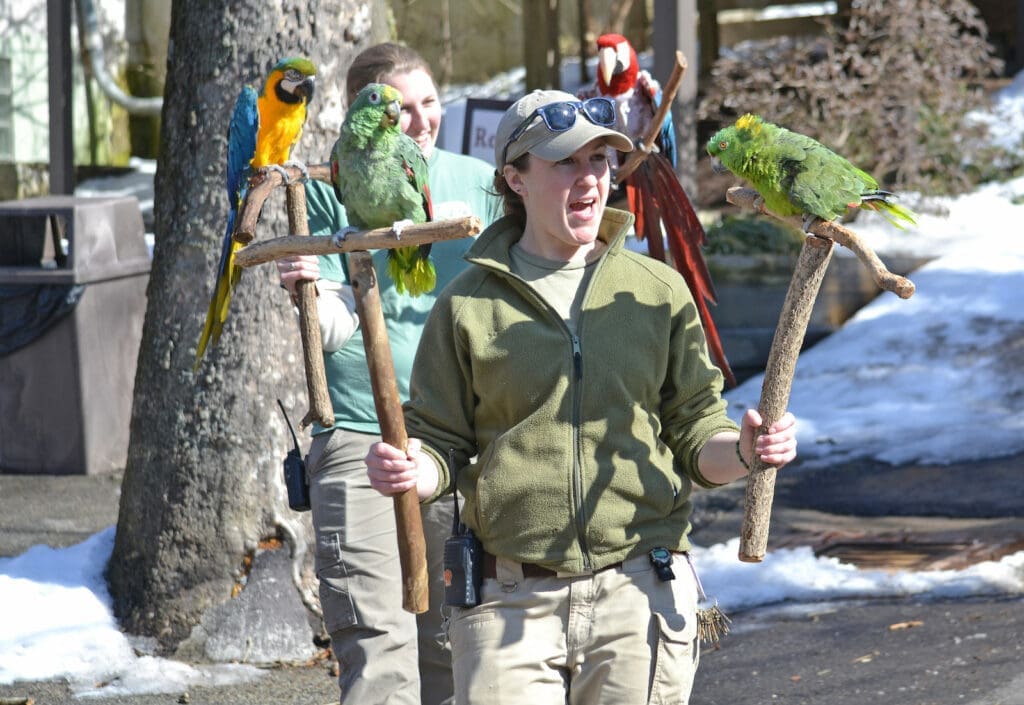
Enhancing Learning and Conservation Efforts
Zoos have been a part of human society for centuries, offering a unique opportunity to observe and learn about animals from around the world. But their role in society has evolved over time, and today, many zoos place a strong emphasis on education. In fact, many zoos see education as one of their primary goals, alongside conservation and research.
The educational role of zoos is multifaceted. Zoos offer a unique opportunity for people of all ages to learn about animals and their habitats, as well as the challenges facing wildlife conservation. Many zoos offer formal educational programs for school groups and other organizations, as well as informal educational opportunities for visitors of all ages. These programs may cover a wide range of topics, from animal behavior and ecology to the importance of biodiversity and the impact of human activities on the natural world.
Historical Evolution of Zoos
Zoos have been a part of human society for thousands of years, with evidence of menageries dating back to ancient Egypt and Mesopotamia. These early collections of animals were often kept for the entertainment of the ruling class and were not open to the general public.
During the Age of Enlightenment in the 18th century, the scientific study of animals became more popular, and zoos began to take on a more educational role. The first modern zoo, the Imperial Menagerie in Vienna, was opened in 1752 and was designed to provide scientific research and education to the public.
In the 19th century, zoos became more popular across Europe and North America, and many of the world’s most famous zoos were established during this time, including London Zoo, the Bronx Zoo, and the Berlin Zoo. These zoos were designed to educate the public about the natural world and to promote conservation efforts.
Today, zoos continue to play an important role in society, providing a unique opportunity for people to learn about animals and their habitats. Many modern zoos are involved in scientific research and conservation efforts, working to protect endangered species and preserve biodiversity.
Overall, the historical evolution of zoos reflects a shift from collections of exotic animals kept for the entertainment of the ruling class to institutions that are dedicated to education, research, and conservation. While there have been criticisms of zoos over the years, they remain an important part of our society, providing valuable opportunities for people to learn about the natural world and the animals that inhabit it.
The Educational Role of Zoos
Zoos have been playing an important educational role in society for many years. They provide a unique opportunity for people to learn about animals and their habitats up close. Zoos offer a range of educational programs and exhibits that cater to all ages and interests.
One of the primary educational roles of zoos is to provide information and knowledge about animals and their habitats. Zoos have a wealth of knowledge about animal behavior, biology, and conservation that they can share with visitors. They offer guided tours, interactive exhibits, and educational programs that help visitors learn about the animals they are seeing. Zoos also have a responsibility to educate visitors about conservation efforts and the importance of protecting endangered species.
Zoos have the potential to enlighten visitors about the world around them. They can inspire visitors to take action to protect the environment and the animals that live in it. Zoos can also provide a unique opportunity for visitors to learn about different cultures and their relationship with animals.
Education is a key component of the modern zoo’s mission. Zoos recognize the importance of offering educational programs and exhibits that cater to all ages and interests. They are constantly developing new exhibits and programs that are designed to be informative, engaging, and entertaining. Zoos also work with schools and community groups to provide educational resources that support classroom learning.
In summary, the educational role of zoos in society is multifaceted. Zoos provide information, knowledge, and enlightenment about animals and their habitats. They inspire visitors to take action to protect the environment and the animals that live in it. Zoos are an important educational resource for schools and community groups, providing a range of educational programs and resources to support classroom learning.
Zoos and Animal Conservation
Zoos play a crucial role in animal conservation efforts worldwide. They are often involved in captive breeding and reintroduction programs, as well as species conservation research. In this section, we will explore the different ways that zoos contribute to animal conservation efforts.
Captive Breeding and Reintroduction
One of the most important roles that zoos play in animal conservation is captive breeding. Captive breeding programs involve breeding animals in captivity for the purpose of reintroducing them into the wild. This is particularly important for endangered species that are at risk of extinction.
For example, the California Condor was on the brink of extinction in the 1980s, with only 27 birds left in the wild. Thanks to captive breeding programs at zoos, the population has now increased to over 400 birds, and the species is no longer considered critically endangered.
Species Conservation
Zoos also contribute to species conservation efforts through research and education. Many zoos have research programs that focus on understanding the biology and behavior of endangered species. This research helps to inform conservation efforts in the wild.
Zoos also play an important role in educating the public about endangered species and the importance of conservation. Through educational programs, zoos raise awareness about the threats that endangered species face and the importance of protecting them.
In conclusion, zoos play a vital role in animal conservation efforts. Through captive breeding and reintroduction programs, as well as research and education, zoos are helping to protect endangered species and preserve biodiversity for future generations.
Zoos and Scientific Research
Zoos have increasingly recognized the importance of scientific research in fulfilling their educational role in society. According to a study by Melfi et al. (2014), over 190 zoos across 52 countries identified a need for greater involvement in scientific research.
In recent years, zoos have been collaborating with researchers to conduct scientific studies on various topics, such as animal behavior, ecology, genetics, and conservation. For example, the San Diego Zoo’s Institute for Conservation Research has been conducting research on endangered species and developing new techniques for animal breeding and reintroduction into the wild.
Zoos have also been using scientific research to improve the welfare of animals in captivity. For instance, researchers at the Smithsonian’s National Zoo have been studying animal behavior to design better habitats that meet the animals’ physical and psychological needs.
However, it is important to note that not all zoos engage in scientific research, and the quality of research can vary widely. Some zoos may prioritize entertainment over education and research, and may not have the resources or expertise to conduct high-quality research. Therefore, it is crucial for zoos to collaborate with reputable researchers and institutions to ensure that their research is scientifically rigorous and contributes to the advancement of knowledge.
Overall, scientific research plays an important role in enhancing the educational value of zoos and promoting conservation efforts. By conducting research and sharing their findings with the public, zoos can help raise awareness about the importance of biodiversity and inspire people to take action to protect our planet’s wildlife.
Zoos and Society
Zoos have long been a popular destination for recreation and leisure, but they also play an important role in society beyond entertainment. Zoos are increasingly becoming important educational institutions that provide opportunities for learning, research, and conservation. In this section, we will explore the role of zoos in society, particularly in terms of recreation and leisure, and community engagement.
Recreation and Leisure
Zoos have been a popular destination for recreation and leisure for decades. They provide an opportunity for people to observe and learn about animals from all over the world in a safe and controlled environment. Zoos offer a unique experience for visitors to see animals up close and personal, which is often not possible in the wild. Moreover, zoos are a great way to spend time with family and friends, and they are often a popular destination for school field trips.
Community Engagement
Zoos play an important role in community engagement. They offer a wide range of educational programs and activities that cater to different age groups. Zoos provide an opportunity for people to learn about the natural world and the importance of conservation. They also offer opportunities for people to get involved in conservation efforts through volunteering and other programs.
Zoos also contribute to the local economy by creating jobs and attracting tourists. They often partner with local businesses and organizations to promote conservation and sustainability. Moreover, zoos are often involved in community outreach programs that aim to educate people about the importance of conservation and environmental protection.
In conclusion, zoos are an important institution in society that provides a unique opportunity for people to learn about animals and the natural world. They play an important role in recreation and leisure, as well as community engagement. Zoos offer a wide range of educational programs and activities that cater to different age groups, and they are often involved in community outreach programs that aim to promote conservation and sustainability.
Understanding Animals and Their Habitats
Zoos play an important role in educating the public, particularly children, about animals and their habitats. By providing a controlled environment where visitors can observe animals up close, zoos offer a unique opportunity to learn about the natural world.
One of the primary goals of zoos is to promote conservation and protect endangered species. Understanding the natural habitats of animals is crucial to achieving this goal. Zoos often create exhibits that replicate the natural habitats of animals, allowing visitors to see how animals interact with their environment and the challenges they face in the wild.
For example, many zoos have exhibits featuring birds of prey, such as eagles and owls. These exhibits often include information about the birds’ natural habitats, such as forests or grasslands. Visitors can learn about the birds’ hunting behaviors, nesting habits, and the threats they face in the wild.
Similarly, zoos often feature exhibits that showcase the natural habitats of elephants. Elephants are social animals that require large areas of land to roam and access to water. Zoos can provide exhibits that replicate these natural habitats, allowing visitors to see how elephants interact with their environment and the challenges they face in the wild.
In addition to providing information about natural habitats, zoos also educate visitors about the importance of protecting these habitats. Many zoos have educational programs that focus on conservation and sustainability, teaching visitors about the impact of human activity on natural habitats and how they can help protect them.
Overall, zoos play an important role in educating the public about animals and their habitats. By providing a controlled environment where visitors can observe animals up close and learn about their natural habitats, zoos promote conservation and help protect endangered species.
Challenges and Problems in Zoos
Zoos play an important role in educating the public about wildlife and conservation efforts. However, they face several challenges and problems that can hinder their educational role in society.
Problems in Zoos
One of the main problems in zoos is animal welfare. Captive animals may suffer from stress, boredom, and health issues due to a lack of space, social interaction, and natural environments. In some cases, zoos have been criticized for mistreating animals, such as confining them to small enclosures or using physical punishment to train them.
Another problem is the breeding of animals in captivity. While some zoos have successful breeding programs that help preserve endangered species, others breed animals for display purposes or to attract visitors. This can lead to overpopulation and a surplus of animals that cannot be released into the wild.
Challenges in Zoos
One of the main challenges facing zoos is the need to balance conservation efforts with visitor entertainment. While zoos must educate the public about conservation, they also need to attract visitors to generate revenue. This can lead to conflicts between the educational and entertainment aspects of zoos.
Another challenge is the need to keep up with changing societal attitudes towards animal welfare and captivity. As society becomes more aware of animal rights and welfare, zoos must adapt to these changing attitudes. This includes providing larger enclosures, more natural environments, and better care for animals.
Conclusion
Overall, zoos face several challenges and problems that can impact their educational role in society. While some zoos have successfully addressed these issues, others continue to struggle with animal welfare, breeding programs, and balancing conservation with visitor entertainment. It is important for zoos to continue to adapt and improve to ensure their educational role in society is effective and ethical.
Role of Zoos in Promoting Health and Well-being
Zoos play an important role in promoting health and well-being in society. They provide a unique opportunity for people to connect with nature and animals, which can have a positive impact on mental and physical health.
Studies have shown that spending time in nature can reduce stress, anxiety, and depression, and improve overall well-being. Zoos provide a safe and controlled environment for people to experience nature up close, which can be especially beneficial for those who may not have access to natural spaces in their daily lives.
In addition, many zoos offer educational programs and activities that promote healthy lifestyles and behaviors. For example, some zoos offer yoga classes or walking tours, which can help visitors stay active and improve physical health. Others provide educational materials and resources on topics such as nutrition and healthy eating habits.
Furthermore, zoos can also play a role in promoting animal welfare, which is closely linked to human health and well-being. By educating visitors about the importance of conservation and protecting endangered species, zoos can inspire people to take action to protect the environment and the animals that inhabit it.
Overall, the role of zoos in promoting health and well-being is an important aspect of their mission. By providing opportunities for people to connect with nature and animals, learn about healthy lifestyles, and promote conservation efforts, zoos can have a positive impact on both individual and societal well-being.
Zoos, Aquariums, and Associations
Zoos and aquariums play a vital role in educating the public about wildlife conservation, animal behavior, and environmental issues. These institutions provide a unique opportunity to learn about animals and their habitats in a controlled and safe environment. Visitors can observe and interact with animals, attend educational programs, and participate in conservation efforts.
Aquariums are similar to zoos, but they focus on marine life. They provide a fascinating glimpse into the underwater world and offer educational programs about ocean conservation. They often feature interactive exhibits that allow visitors to touch and learn about sea creatures.
The Association of Zoos and Aquariums (AZA) is a non-profit organization that accredits zoos and aquariums in the United States and other countries. Accreditation is a rigorous process that ensures that institutions meet high standards of animal care, education, and conservation. AZA-accredited institutions are required to participate in research, conservation, and education programs.
The AZA also provides resources and support to member institutions, including training programs for staff and volunteers, grant opportunities, and advocacy for animal welfare and conservation issues. The AZA is committed to promoting the educational role of zoos and aquariums and encouraging public engagement in conservation efforts.
In conclusion, zoos, aquariums, and associations such as the AZA play a crucial role in educating the public about wildlife conservation and environmental issues. These institutions offer a unique opportunity to learn about animals and their habitats in a safe and controlled environment. By participating in research, conservation, and education programs, they help to promote a greater understanding and appreciation of the natural world.
The Modern Zoo: Responsibilities and Desires
Modern zoos play a crucial role in society, serving as a hub for education, conservation, research, and entertainment. The responsibilities of modern zoos have evolved over time, and they are now expected to serve as centers for education and conservation. Zoos are also expected to provide an entertaining experience for visitors while promoting animal welfare.
Zoos are responsible for providing a safe and comfortable environment for animals, and they must ensure that the animals are well-fed, healthy, and happy. In addition, modern zoos must also educate visitors about the importance of conservation and the role of zoos in preserving endangered species.
The desire of modern zoos is to provide visitors with an unforgettable experience. This experience should be both entertaining and educational, and it should leave visitors with a greater appreciation for the natural world. Zoos strive to create an environment that is both engaging and informative, using a variety of exhibits, interactive displays, and educational programs to engage visitors of all ages.
In conclusion, modern zoos have a responsibility to educate visitors about the importance of conservation and animal welfare while providing an entertaining experience. The desire of modern zoos is to create an environment that is engaging, informative, and unforgettable. Zoos must continue to evolve and adapt to changing societal expectations while fulfilling their responsibilities as centers for education, conservation, and research.




